| Columns Retired Columns & Blogs |
Hello John ,
I still Can’t wrap my head around how badly Class D amplifiers measure on square-waves , Thinking this must lead to why most hear odd timbre from them especially on difficult to drive loudspeakers ..
I measured NAD's Masters Series M33 using my Audio Precision SYS2722 system (see the January 2008 "As We See It"). Usually, before I test an amplifier, I precondition it with both channels driving a 1kHz tone at one-third power into 8 ohms for an hour. This thermally stresses an amplifier with a conventional class-AB output stage, but as the NAD is a class-D design, this wasn't necessary. However, before doing any testing I ran the M33 for an hour to ensure that it was fully warmed up. At the end of that time, the top panel was slightly warm, at 100.7°F/38.2°C. Because class-D amplifiers emit relatively high levels of ultrasonic noise that would drive my analyzer's input into slew-rate limiting, all measurements other than the frequency response and squarewave tests were taken with Audio Precision's auxiliary AUX-0025 passive low-pass filter, which eliminates the ultrasonic noise.
Looking first at the analog inputs: With the NAD's volume control set to its maximum of "0.0dB," the voltage gain at 1kHz into 8 ohms measured 33.3dB at the speaker terminals with both balanced and unbalanced inputs. The maximum gain at the headphone output was 9.4dB and at the preamplifier output was 5.3dB. The line inputs preserved absolute polarity (ie, were noninverting) at all three sets of outputs. The single-ended input impedance was a usefully high 50k ohms at low and middle frequencies, dropping slightly to 36k ohms at 20kHz. The balanced input impedances were twice these values, as expected, except at 20kHz, where it was 92k ohms. The headphone output impedance was a very low 2.8 ohms rather than the specified 22 ohms. At the preamplifier outputs, the impedance was an appropriately low 100 ohms at 1kHz and 20kHz, rising slightly but inconsequentially to 124 ohms at 20Hz.
The M33's output impedance at the speaker terminals was a low 0.08 ohm at 20Hz and 1kHz, rising to 0.1 ohm at 20kHz. (These values include the series impedance of 6' of spaced-pair loudspeaker cable.) Fig.1 shows the frequency response at the speaker outputs, with the M33's A/D converter set to its maximum sample rate of 192kHz. Unlike the M32, where a peak developed at the top of the audioband, especially into higher load impedances (footnote 1), the M33's audioband output is flat and rolls off above 20kHz, reaching –3dB at 55kHz. However, note the imbalance between the channels, with the left channel (blue and cyan traces) 0.6dB higher in level than the right (red and magenta). (The balance control in the front-panel Player menu was centered for the measurements.) With the amplifier's very low output impedance, the response with our standard simulated loudspeaker (gray trace) varies by just ±0.05dB. Measured at the preamplifier and headphone outputs with the A/D converter set to 96kHz, the response extends to just above 40kHz, but a slight amount of passband ripple can be seen (fig.2).
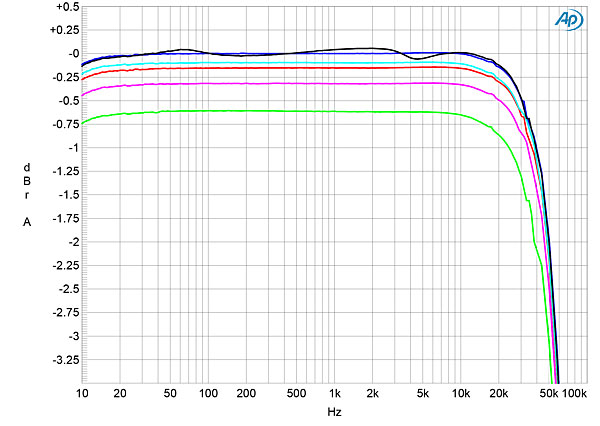
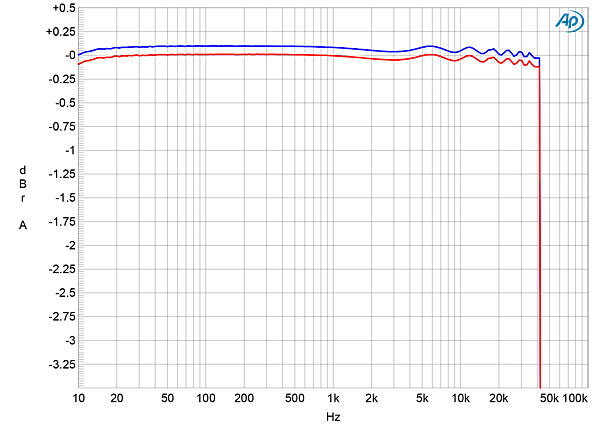
Fig.3 shows the effect of the M33's bass and treble controls set to their maximum and minimum positions and with the converter sample rate set to 96kHz. Both controls offer a sensible range of ±6dB, as specified. With the tone controls bypassed and without the external Audio Precision low-pass filter, the M33's reproduction of a 10kHz squarewave featured a slight, critically damped overshoot. (The level of ultrasonic noise in this graph has been reduced by averaging 32 captures.)
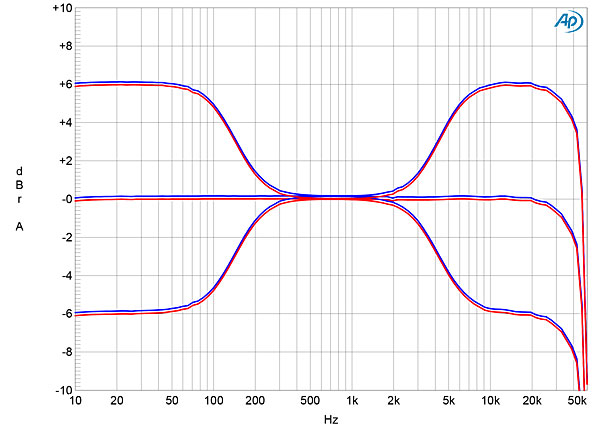
Channel separation was excellent, at >100dB in both directions below 1kHz, decreasing to 72dB at 20kHz. Without the AP low-pass filter and with no signal present, about 220mV of ultrasonic noise was present at the speaker outputs. With the filter, the single-ended analog inputs shorted to ground, and with the volume control set to "0.0dB," the wideband, unweighted signal/noise ratios (ref. 2.83V into 8 ohms) were significantly better than those of the M32, at 75.8dB in the left channel and 73.8dB in the right. Restricting the measurement bandwidth to 22kHz increased the ratios to 85.4dB, left, and 78.3dB, right, and an A-weighting filter increased both to 91.5dB. Levels of any residuals at the AC power-line frequency and its harmonics were negligible (fig.5).
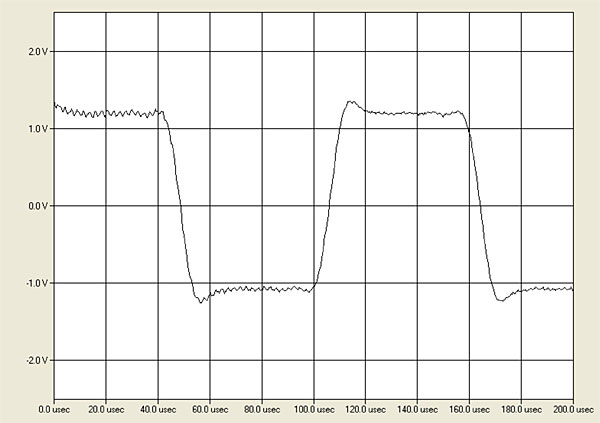

The M33 is specified as clipping at 210Wpc into 8 ohms (23.2dBW). At our usual definition of clipping (ie, when the percentage of THD+noise in the amplifier's output reaches 1%, footnote 2), with continuous drive and both channels driven, the M33 exceeded the specified 8 ohm power, delivering 255Wpc (fig.6, 24.1dBW). NAD doesn't specify the continuous clipping power into 4 ohms; I measured 460Wpc into 4 ohms (fig.7, 23.6dBW). This is an approximate figure, as the amplifier's protection circuit operated intermittently at powers above 400W.
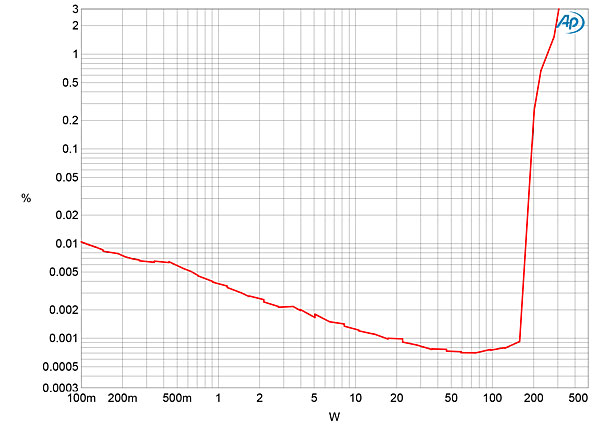
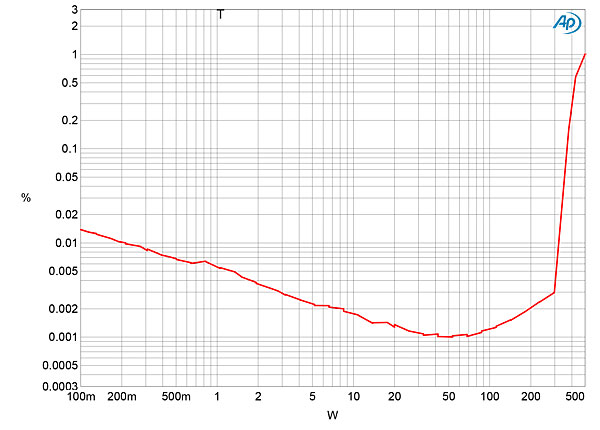
The shape of the traces in figs.6 and 7 reveals that any distortion lies below the noise levels at powers below a few tens of watts. I therefore investigated how the THD+noise varied with frequency at a level of 20V, equivalent to 50Wpc into 8 ohms and 100Wpc into 4 ohms. Distortion levels were very low in both channels into 8 ohms (fig.8, blue and red traces), but into 4 ohms were higher in the right channel (magenta trace) than the left (cyan trace). The shape of the spuriae waveform at 100Wpc into 4 ohms (fig.9) suggests that the distortion signature is primarily third-harmonic in nature; this harmonic was higher in the right channel (fig.10, red trace) than the left (blue trace). Intermodulation distortion at high powers was low even into 4 ohms (fig.11).
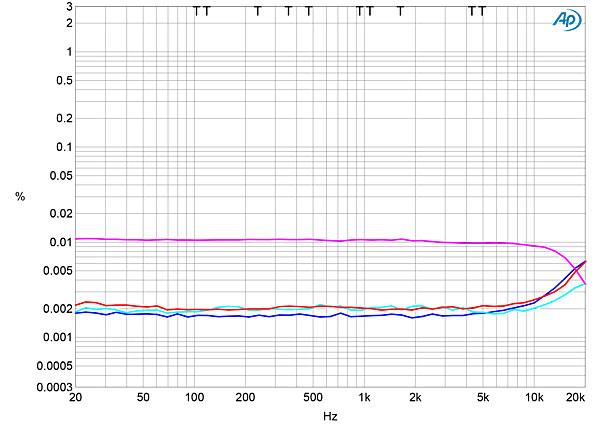
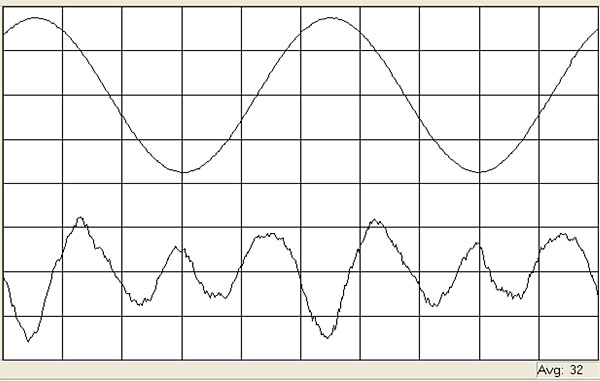
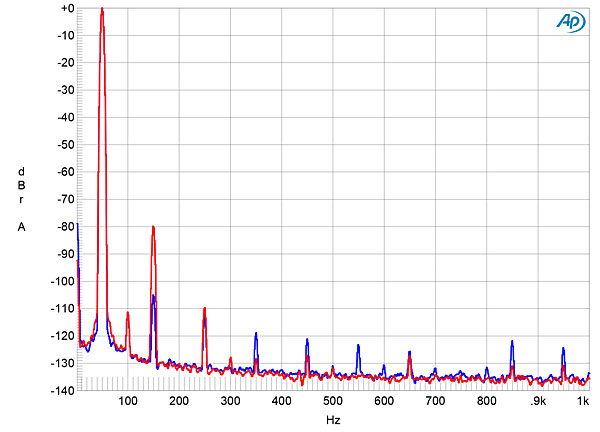
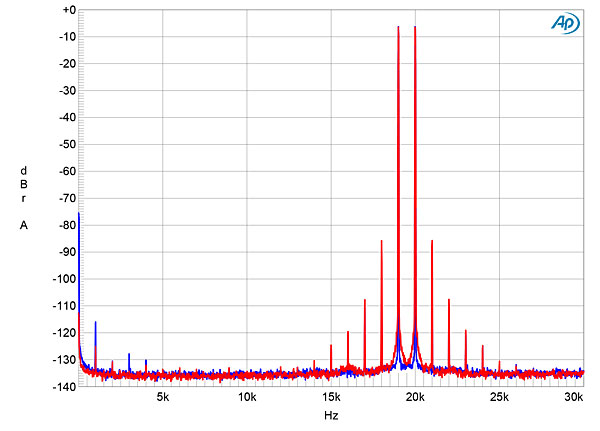
Turning to the digital inputs, a 1kHz digital signal at –20dBFS resulted in an output level of 9.62V into 8 ohms with the volume control set to "0.0dB," which suggests that these inputs have too much gain: A full-scale digital signal would result in an output voltage that's far beyond clipping. (The M33 does allow each input's sensitivity to be lowered.) The levels at the preamplifier and headphone outputs at –20dBFS were 382mV and 607.5mV, indicating that a digital signal at 0dBFS will not clip these outputs. To avoid damaging the M33's output stage with full-scale digital signals, I measured the behavior of the digital inputs at the headphone output, which mutes the speaker outputs. (Only after I had concluded the measurements did I find a menu item that allows the speaker outputs to be turned off.)
The AES/EBU and coaxial and optical S/PDIF inputs locked to datastreams with all sample rates up to 192kHz. The NAD's impulse response with 44.1kHz data (fig.12) indicates that the reconstruction filter is a conventional linear-phase type, with time-symmetrical ringing on either side of the single sample at 0dBFS. With 44.1kHz-sampled white noise (fig.13, red and magenta traces), the M33's response rolled off sharply above 20kHz, reaching full stop-band suppression just above half the sample rate (vertical green line). An aliased image at 25kHz of a full-scale tone at 19.1kHz (blue and cyan traces) can't therefore be seen, though the distortion harmonics of the 19.1kHz tone are visible above the ultrasonic noise floor, the third harmonic being the highest in level at just –86dB (0.005%).
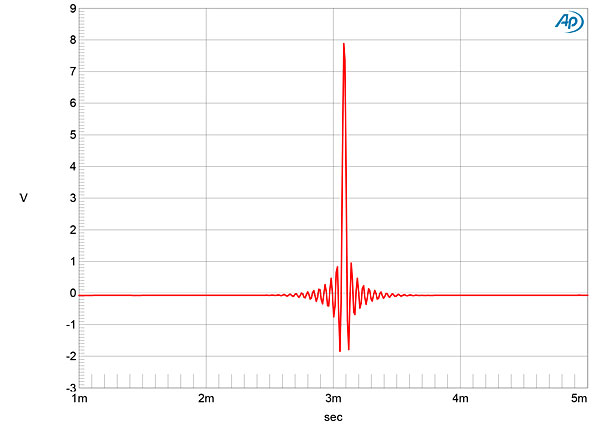
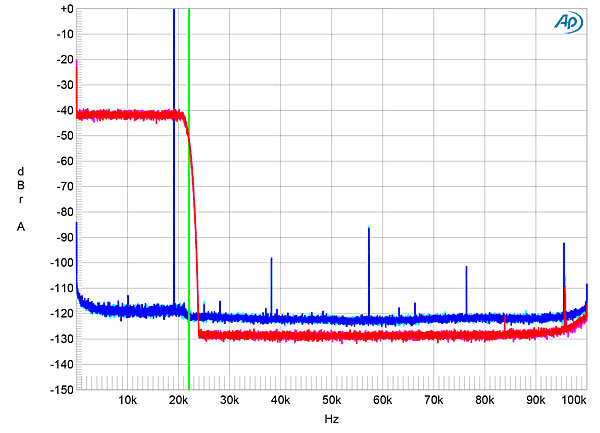
When I increased the bit depth from 16 to 24 with a dithered 1kHz tone at –90dBFS (fig.14), the noise floor on average dropped by almost 30dB, though the floor with 24-bit data was rather dirty-looking. The M33 offers at least 20 bits of resolution, therefore, which is excellent for an integrated amplifier's digital section. With undithered data representing a tone at exactly –90.31dBFS (fig.15), the three DC voltage levels described by the data were well resolved, and the waveform was perfectly symmetrical. With undithered 24-bit data, the result was a clean sinewave (fig.16).
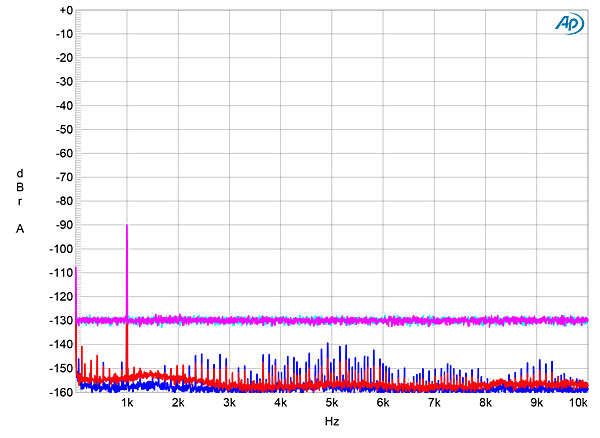
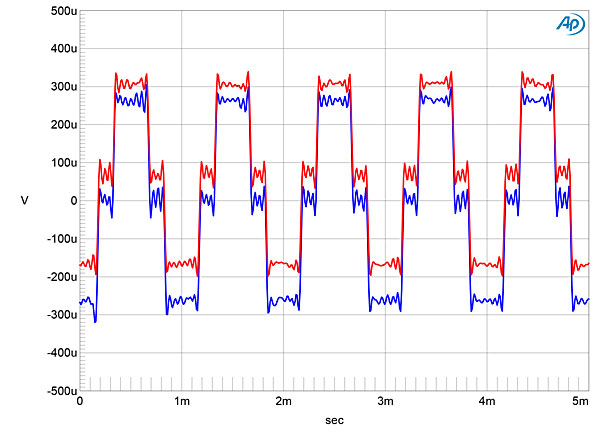

The NAD's rejection of word-clock jitter with 16-bit TosLink data (fig.17) was superb, with all the odd-order harmonics of the LSB-level, low-frequency squarewave at the correct levels (fig.15, sloping green line). With 24-bit J-Test data (fig.18), no jitter-related sidebands were present. The M33 replaces the M32's USB input with an Ethernet port. Repeating the jitter testing with data sourced over my network with Roon revealed no differences from the measured performance with S/PDIF and AES/EBU data.
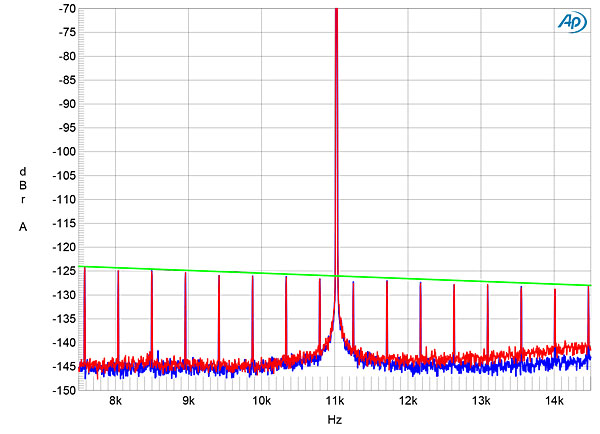
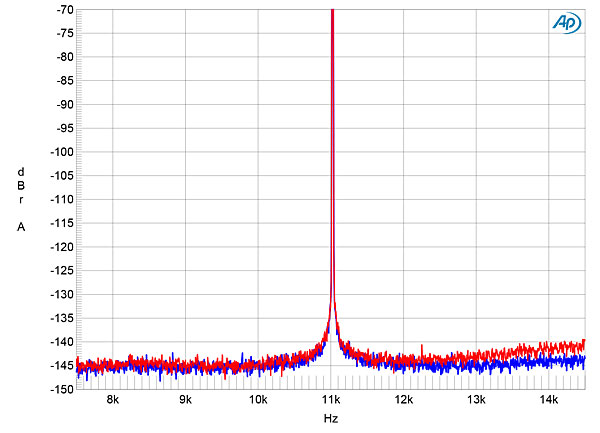
I set the M33's A/D converter to a sample rate of 192kHz for the phono input measurements. (Although the amplifier's information sheet mentions a "Direct" mode for this input, bypassing the A/D converter, I could not find any way to select this mode, either with the Player or Source Setup menus.) I examined the behavior of the phono input at the headphone output, as in MC mode, with the input's level adjust set to "0.0dB," the possibility existed of driving the loudspeaker outputs into clipping. The maximum gain in MC mode was a very high 90.6dB at the speaker outputs, 62.3dB at the preamplifier outputs, and 66.4dB at the headphone outputs. In MM mode, the maximum gains were 68.6dB (speaker), 40.34dB (preamplifier), and 44.4dB (headphone). The MM gains are all appropriate for typical moving-magnet phono cartridges, but the MC gain is a little on the high side.
Both MM and MC modes preserve absolute polarity. In MM mode, the input impedance was slightly low, at 26k ohms at 20Hz and 1kHz, and 23.5k ohms at 20kHz. In MC mode, the input impedance was an appropriately low 127 ohms across the audioband. The RIAA error was both very low and well-matched between channels (fig.19), and channel separation was excellent at >80dB in both directions from 20Hz to 20kHz. In MM mode, the phono input's wide-band, unweighted S/N ratio, ref. 1kHz at 5mV, was excellent at 69.75dB, this improving to 80.2dB when A-weighted. In MC mode, the unweighted S/N ratios were about 9dB lower than in MM mode but a still good 61.1dB when A-weighted.
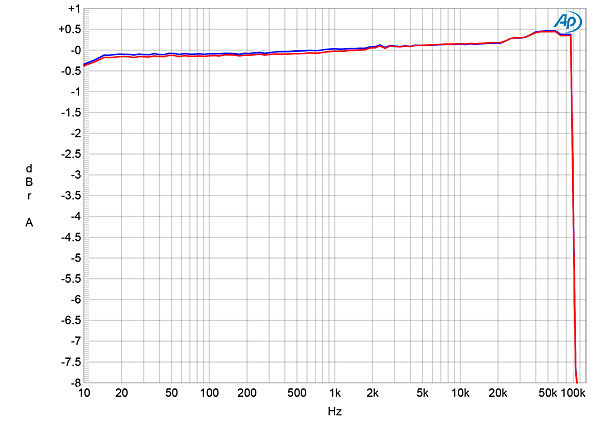
The phono input's overload margins were also excellent, at 18dB across the audioband in MM mode and 16.4dB in MC mode. In every case, the 1% THD+noise figure was equivalent to the headphone output clipping at just over 6V into 100k ohms. Both harmonic distortion and intermodulation distortion were extremely low via the phono input. In MM mode with a 1kHz signal at 20mV, ie, 12dB higher than the nominal 5mV level, the third harmonic was the highest in level, but still it lay at just –100dB (0.001%).
Like its predecessor, NAD's M33 packs a lot of well-engineered performance into its relatively small chassis. It improves on the M32's performance in several areas.—John Atkinson
Footnote 2: NAD specifies clipping power at a more conservative 0.1% THD.

Hello John ,
I still Can’t wrap my head around how badly Class D amplifiers measure on square-waves , Thinking this must lead to why most hear odd timbre from them especially on difficult to drive loudspeakers ..

A square wave mostly shows frequency range. This amp reaches the bottom of the graph at 50kHz, so naturally the square wave won’t look as good as an amp that is flat to 100kHz. A square wave is made up by adding harmonics of sine waves, so naturally if the harmonics are lower in level, it’ll look less like a square wave. A square wave doesn’t tell us anything that can’t be obtained from other graphs.
Go back to last measurements and you’ll see the same thing, the amps that can get close to a square wave have an extended frequency response. So, you have to believe that we can hear >20kHz in order to believe a difference in quality can be obtained by having a better looking square wave.
As for difficult to drive speakers, that is based on their impedance/phase. Two amps could have identical wattage using 4ohm load test, but the actual wattage available could be drastic if the speaker has say -45° phase and 4ohm and 100Hz. The tonal balance can also be altered by having low output impedance (low damping factor).

Great review as always Kal!
Question for John: Is there a reason for using the analog input for the THD+Noise tests on integrated amplifiers that digitize their inputs?
These new breed of devices are obviously designed with playback of digital sources at the forefront. I think that publishing the end-to-end measurements for digital audio input -> amplifier output would serve the best educational interests for the readership-at-large.
This isn't to say that the analog input -> amplifier output measurement isn't useful... would be great to have both!

Looks fantastic, but I'm really disappointed that the M33 doesn't have a USB-B input for hooking up a computer. That's almost a dealbreaker for me.

Same here, deal breaker for me.

High-End performance for everyman annnndddddd at everyman's price, egads, this device drove your Revels to convince even you, phew!
I'm wondering, what reward comes from spending 10x or 20x this kind of money for electronics?
I recall when the NAD 3020 marked the beginning ( 1978ish ) of an exciting Audiophile world, is this M33 guiding us safely/pleasantly/joyfully into the 21st Century? I wish it was made in Toronto. ( or Valencia, Ca. )
Thank you for another adventure , your writing never seems like a 'paint by numbers' review as is so common today.
Tony in Venice

Regarding Roon:
I have heard reports that the M33 does not support Roon and that I must have reviewed a "special" version not available to the public. I do not believe that is true.
The time I had the M33 was prior to 9/21. It was on that date that Roon cut off working with non-certified devices although Roon asserts that those already registered in use will have continued support. Only new ones will not be recognized until the device is certified. See: https://community.roonlabs.com/t/uncertified-roon-ready-devices-announcement/120298
When I learned of this change, I asked NAD about support for the M33 and the response they sent is as follows: "
“As Roon explain themselves, any device that has been used prior to Sep 21st, even in an uncertified way, will continue to work. The NAD M33 is with Roon for final certification approval and both companies are working together to have this completed as soon as possible.”
I did note, in the review, that the M33 was not yet certified but that it worked. That is true and, I believe, true for all M33s put into Roon use prior to 9/21. However, any newly purchased M33, although identical in all ways to the one I had, is likely to be ignored by Roon if the user attempts to register it with Roon after 9/21 and before Roon/NAD work out the certification.
I hope that this makes the current situation clear and that the certification issues will be completed soon.

Best kept secret

Thanks for this review, Kal.
I'm really loving the idea of this amp and minimizing my setup, but I'm also into vinyl.
Did you experience any vinyl using the digitized RCA inputs?
That would be the crux for me pulling the trigger on this, as I love all the convenience it offers for digital but I need a competent phono stage as well.

Hi,
Enjoyed your review even though I didn't quite understand all of the test results (all? Hardly! But a few, hopefully, LOL).
In reading page 2 where you discuss the amplifier component of the M33, and the testing page, I was hoping you could comment on the M33's ability to dirve low loads. I have a pair of Infinity Kappa 8's which present very low (1.3) and varying loads throughout the range.
How does this new-style class-D amplifier section handle low loads like that? Is it stable or should I just stay clear of it and buy a McIntosh?
Warmly,

Just FYI, the M33 is now considered (officially) Roon Ready and Roon Tested: https://roonlabs.com/partners/nad
I did it with my M33 recently... no problems whatsoever.